I’ll go ahead and say it: almost everything we’ve heard about PSVR 2 sounds amazing.
Yes, the wire hurts and yes we’re probably talking about an expensive machine. Those issues aside, a device with better resolution than Quest 2, packed in with controllers with improved haptics, all boosted by the power of the PS5 and accelerated by smart software techniques like foveated rendering starts to paint a very promising picture for Sony’s next VR effort.
What most excites me about PSVR 2 isn’t the hardware, though, it’s the games.
As part of PSVR Without Parole’s report on this week’s Sony VR developer summit (which we also verified took place), the company allegedly expressed a desire to bring AAA, console-quality games to the new headset by appealing to flatscreen developers to implement optional support into their titles. Think along the lines of existing VR support for PS4 games like Resident Evil 7, No Man’s Sky and Hitman 3.
Immediately, the mind sets ablaze with possibilities. Post-launch support for Resident Evil 8 and potential day one integration for Gran Turismo 7 is an incredibly potent pairing to appeal to hardcore gamers when the device launches (hopefully) next year. From there, who knows where we could go; prized PlayStation brands from world-class developers seem ripe for VR integration, as do a number of third-party efforts. If I was Sony, for example, I would be throwing money at EA to make sure that Dead Space remake arrives with full PSVR 2 support. It’s exactly what I said the company should be doing at the beginning of last year.
I do want to spare a thought, though, for the potential caveats of this situation.
By now, I think the question’s been pretty definitively answered; yes, you can port non-VR games into VR and, with enough time and consideration, either make a great experience or at the very least amplify what’s already there. Resident Evil 7 might not have been a fully-tracked and completely immersive VR game, but just seeing its terrifying world inside a headset was more than enough to enhance the atmosphere. Hello Games, meanwhile, went above and beyond to make No Man’s Sky’s VR integration feel native. It doesn’t always work, of course. Some games like (don’t shoot me) Doom 3 just never really felt like they suited VR in the first place.
But what none of these experiences offer, to my mind, is what I’d call the bleeding edge of VR game design.
By that, I’m mean when a world is intrinsically built to be experienced in VR, to the point you simply can’t replicate the experience on a flatscreen. I mean the moment you first threw yourself through zero gravity in Lone Echo. I mean that part of Boneworks you realize you can hook your crowbar on the ledge of a platform and use it to climb up, or grab one of the game’s robotic spiders by any leg and swing it above your head. I mean the moment in The Walking Dead: Saints & Sinners when you master the exact technique needed to solidly plant an axe in a zombie’s head and the quick yank needed to remove it once more. And I definitely mean that moment in Half-Life: Alyx when you have to get uncomfortably close to a certain monster.
These, for me, are definitive VR moments, genuine glimpses of the future and how we can use this technology in incredibly different ways. And these aren’t achieved by going back and wedging in VR support in the middle of a development cycle. They’re also not experiences you can easily make well in VR and keep the flat version compelling – Boneworks and Saints & Sinners just wouldn’t work half as well on a controller without that spatial reading of the environment.
I’m all for Sony doubling down on AAA VR – I’m sure you can implement motion controller support into Deathloop and end up with a game that’s just as compelling inside a headset. But it’s also crucial that Sony doesn’t forget those native experiences that push the industry forward. It helped expand those horizons with the VR-first design of Astro Bot, the immersive superheroics of Iron Man VR and the highly interactive action of Blood & Truth and, undeniably, you couldn’t make a flatscreen version of any of those games that mirrored the VR experience. You can still take Astro and make magic like with PS5’s Playroom, but it’s a fundamentally different experience to Rescue Mission.
Sony can’t lose sight of that even as it doubles down on bringing more AAA developers to VR. PlayStation still needs to be investing in native, VR-only experiences too. We’ll no doubt see strong support from indies that are all-in on VR but it’s inherently riskier to release something that can only be sold to PSVR 2 owners and not the wider PS5 install base.
Fortunately it seems like the company understands this. PSVR is enjoying a strong final year in which Sony got behind not only VR-supported games like Hitman 3 but also ambitious new native titles like Fracked fron nDreams and Endeavor One’s Arashi: Castles of Sin. Those studios will continue to need support from platform holders to justify those risks, and not be passed up in favor of games that were already going to be successful without VR integration. If Sony really wants to make a mark on the industry with PSVR 2, it needs to nurture the content that really sets the medium apart just as much as it does the blockbuster experiences we all want.





























